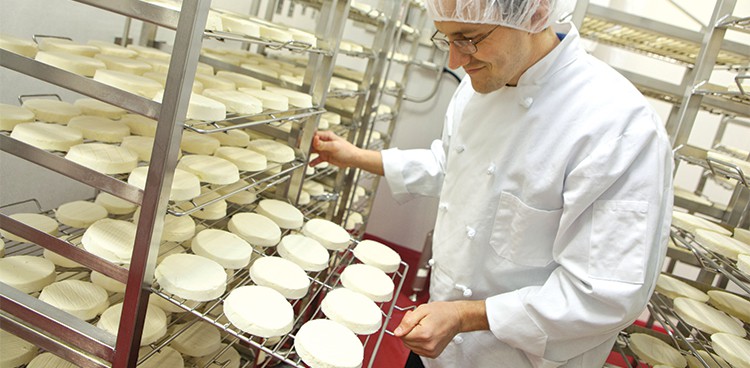
A beckoning, beguiling funk hits me as I walk into the brand-new cheese aging facility at Wegmans Food Markets during a preview in late March. Situated in Chili, a suburb of Rochester, N.Y., the multimillion-dollar, state-of-the-art affinage facility is the first of its kind for an American supermarket chain. The operation boasts seven highly controlled aging “caves” spread across the 12,300-square-foot complex. A tasting area and exhibition kitchen lend views into several of the white-walled, concrete-floored aging rooms, which are filled with racks of test-batch cheeses. Soon those cheeses will be dispatched to 83 Wegmans stores throughout the Northeast.
The company aspires to offer customers house-aged washed-rind and soft-ripened cheeses at their highest level of freshness.
“Those are the hardest to work with,” says Wegmans director of specialty cheese Cathy Gaffney, who helmed the project. “If they’re overripe or underripe, you’re not going to like the product.”
For years, Gaffney and her associates had tried to figure out how to best transport these types of cheeses. They worked with producers to tighten supply chains, and had cheeses shipped at various stages in their aging processes, so they would arrive in peak condition. They even had several in-store aging cases custom built, but the cheeses dried out due to aggressive airflow from the refrigeration units.
There was another problem, too: “We had to educate more than 80 stores on what to do with each cheese,” Gaffney explains. She’s perched next to a counter in the tasting area, the word “cheese” written on the overhang above her in a couple dozen languages. “It’s not like bananas, where it’s one item—every cheese is different. The amount of time we were taking to train people … was not sustainable.”
Gaffney spent the last six years rethinking this complex issue. She spoke to dozens of experts in every area of the industry and traveled across the US and Europe to research affinage setups, from modernized operations to artisans practicing classic techniques.
“Some of the aging caves in France are built into a hill or are underground,” Gaffney says. “When they need humidity, they wash down the stone on the ground. That didn’t fly with our food safety experts.”
At the conclusion of Gaffney’s investigations, she had a pile of notes from a slew of sources. But “there was nothing like what we wanted to build,” she says. “We married what we saw in a lot of different places around the world and came up with our own design.”
Gaffney hopes the launch will be a “game changer,” separating Wegmans’ washed-rind and soft-ripened cheeses from those offered by competitors. “Everybody is faking it,” cabinet, I’m aging cheese.’ We want to truly transform cheese and do the real thing.”
Built with the help of outside consultants, the new Wegmans facility contains seven micro-environments, where temperature, humidity, and airflow are carefully controlled, and molds and bacteria are cultivated and contained. Outside oxygen travels through three different filters before cheeses are exposed. “It’s almost operating-room clean,” Gaffney says.
The seven rooms—one 385 square feet, and the others 185 square feet each—can age up to approximately 45,000 cheeses simultaneously. A backup generator ensures that cheeses won’t spoil in the event of a power failure. Site work for the facility began in early 2013, and the first batches of cheeses went into the caves this past March. Gaffney oversaw the project in concert with the company’s newly hired affineur, Eric Meredith. The Massachusetts native was lured away from a six-year apprenticeship with famed French cheesemonger Hervé Mons.
Meredith, who is also a classically trained chef and a registered dietician, hopes to teach Wegmans customers about the joys of soft cheeses, which most Europeans take for granted.
“Eight out of 10 people I talk to in the States tell me you need to put a Brie in the oven,” he says with a rueful shake of his head. “We want to teach people that a perfectly aged cheese doesn’t need that.”
Wegmans is creating its own brand of soft-ripened and washed-rind varieties by partnering with boutique cheesemakers, who will produce unique cheeses for the supermarket chain based on recipes and input from Gaffney and Meredith. To help smaller producers improve safety standards and production processes, the chain has donated $360,000 to Cornell University to create a pilot program that will aid an initial group of five cheesemakers.
“These are folks that have the vision, the property, animals, knowledge, and passion,” Gaffney says, “but they can’t go from zero to 90.”
The first collaborations are with established cheesemakers, though Gaffney is tight-lipped on most of their identities. One partnership she happily reveals is with Vermont Creamery, which is producing thin, 5-inch-wide discs of fresh goat cheese. The tart, tangy, and slightly sweet round is dubbed “1916” for the year Wegmans was founded. During its three-week aging process, the Wegmans logo is stenciled on top in decorative, edible vegetable ash.
After I sign a waiver and don a hairnet, foot covers, goggles, and a lab coat, Meredith takes me into the facility to show off another signature creation in production. Two assistants are carefully washing wheels of cheese. One is dipping his left hand carefully into a mixture of diluted bourbon, to rub on French cheese Pié d’Angloys. The rind has taken on a dusky sunflower that is sure to be striking in the cheese case; it will be shipped to stores after three weeks of washing and aging. Cutting into the end result reveals a gloriously gooey interior with a bourbon-y bite.
Other cheeses are washed in New York state beer and Washington state Riesling. “We’re always researching and developing other products to find out what works and what doesn’t,” Meredith says. “We’re hoping to create some American originals here.”





